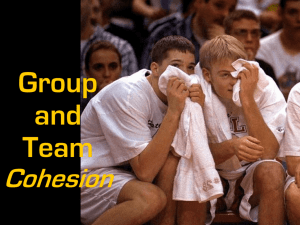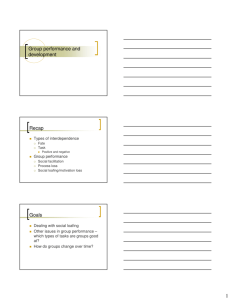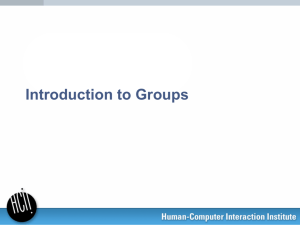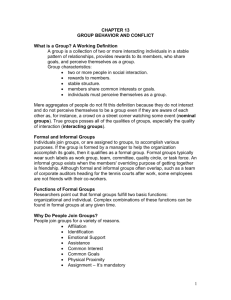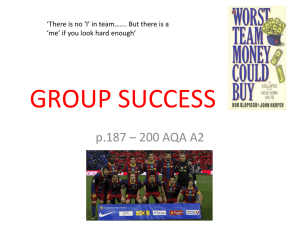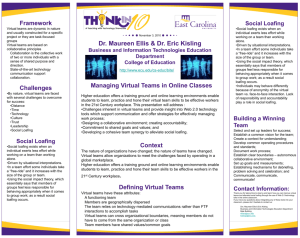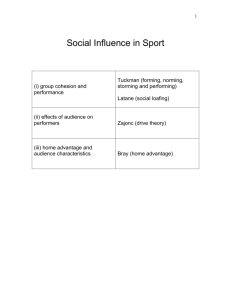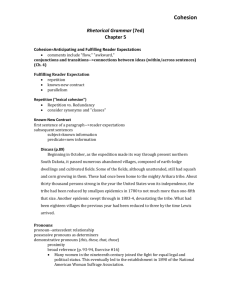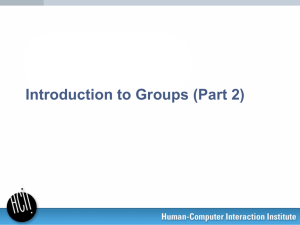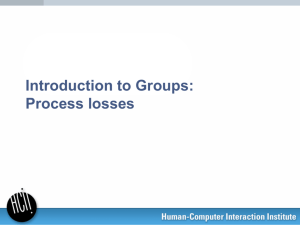Intro to groups - Organization Communication 2014
advertisement
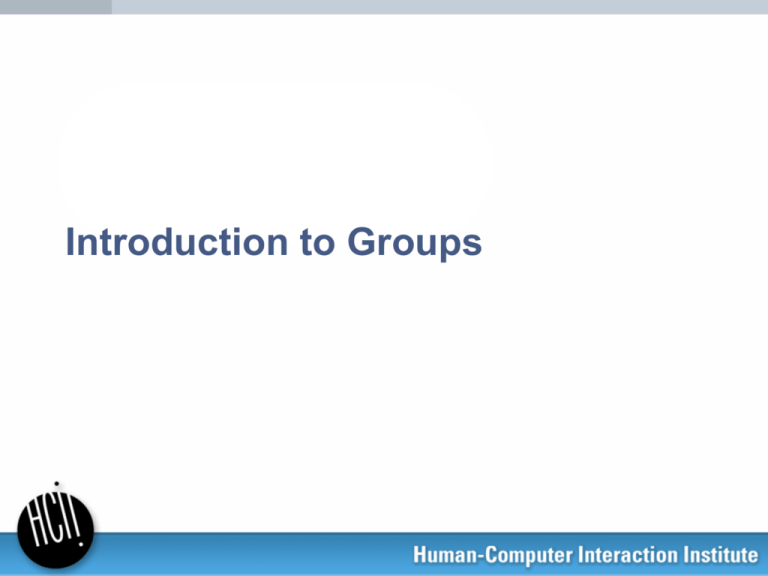
Introduction to Groups Lessons for Today 1. Groups are valuable. a. 2. Groups often do better than the individual in them. They allow people to handle projects that are too large or complex for a single individual. The success of a group consists of three components: a. b. c. Getting the work done Supporting the needs of individual members Keeping the group as an unit functioning. These outcomes are only loosely related. 3. Groups are often afflicted by "process losses", which prevent them from doing as well as they are capable of doing: a. b. c. 4. Problems in coordination Problems in motivation i. Social loafing & ways to control it ii. Problems of diversity (I'm not sure how to control this) Problems in resolving conflict Success also depends upon communication outside the group a. b. c. Client – know what they want & convince them that what you have is it Subject matter experts Users Groups 1. 2. 3. 4. Groups = social aggregates that involve mutual awareness & potential mutual interaction. For our purposes, also have a common goal of producing something a. Standing groups defined by identity and stable pattern of relationships b. Acting group defined by pattern of interaction Kinds of groups a. Ad hoc groups – Lab groups with no history or organizational context b. Teams - Groups with organizational embedding, internal differentiation & common goal Groups have pervasive, persistent & powerful effects on human behavior Large number of stylized facts about how groups & teams operate a. Social psychology – Focus on ad hoc, contextless, laboratory groups b. Organizational behavior – Focus on embedded, production teams Groups are valuable • Way to pool resources to tackle problems that are too large or complex for an individual to solve • Effort - e.g., construction gang, large software development projects • Expertise - e.g., teaching this course, executive team • Interests - e.g., school board, Congress • Perspective/Point of view - e.g., human subjects review board • In many task groups do better than the individuals comprising them • E.g., Problem solving • Groups are more likely to solve problems than average member • E.g., Learning • Students often learn better thru cooperative learning teams in schools than through individual instruction • Advantage depends upon the task & whether the group is interacting or a statistical aggregation High school dating network: How many males (blue?) Data drawn from Peter S. Bearman, James Moody, and Katherine Stovel, Chains of affection: The structure of adolescent romantic and sexual networks, American Journal of Sociology 110, 44-91 (2004) Eureka Tasks:Truth Revealed Wins Group problem-solving example Causes of death was the 10th leading cause of death in the US in 2007, with 9.2 suicides per 100,000 in the population • What is the suicide rate of different demographic groups in the US (per 100,000 in the group) to one decimal point? • Suicide • White males • White females • Black males • Black females Base rate 9.2 9.2 9.2 9.2 Self Discuss ______ ______ ______ ______ Actual ______ ______ ______ ______ • Which ______ ______ ______ ______ demographic group has the lowest suicide rate? Estimate it in number per 100,000 of that demographic group. • Procedure • First make your estimate individually • Form 3-person groups: • Reach a consensus answer with group in 3 minutes McGrath’s Task Typology Cooperative Generate Creative Planning Intellective Performance/psychomotor Execute Choose Decision making Competitive tasks Cognitive conflict Negotiate Mixed motive Competitive Conceptual Behavioral What Processes Help Groups Succeed? What Processes Help Groups Succeed? • • • • • • • Law of large numbers & central limit theorem: Average of many independent judgments drawn from a single distribution is closer to the true value that any single estimate Aggregation of resources: Diversity of knowledge, skills, abilities, and approaches enhances creativity, problem solving, and decision quality Synergy-Contribution by one member sparks contributions by others Creative conflict: Task-based conflict brings out different ideas and solutions Efficiency: Groups offer opportunities for division of labor Commitment fosters decision understanding and acceptance Learning: Participation builds members’ skills Brief case: Rowing in an 8 Discussion • Was this crew successful? • How did they achieve their success? Army Crew case: Causes • Why is varsity losing to JV team – Common approach to dealing with the cases • What are the root causes of the problem – What are the important concepts? – What are the pathways? – What is the evidence? Some summary points • • • Illustrates process losses Failures in team cohesion, team-level trust & attributing team performance (not individuals) to the team may have caused team to fail Components of cohesion – Identification with the team-as-a-whole – Liking of individual teammates • Interplay between team cohesion & performance – Effects are bi-directional – Performance cohesion is stronger than cohesion performance – Cohesion/performance relationship is stronger for more interdependent task Group cohesion & performance • Meta-analyses of 66 studies show reliable correlations btw cohesion & group performance Beal, D. J., Cohen, R. R., Burke, M. J., & McLendon, C. L. (2003). Cohesion and Performance in Groups: A Meta-Analytic Clarification of Construct Relations. Journal of Applied Psychology, 88(6), 989-1004. Fixes • Given these causes, what are the options for fixing the problem? – – – – To prevent the problem To fix a team in crisis Why will your solution work? What are the risks? Root causes Fixes • Lack of trust among teammates – Trust in particular rowers – Trust in team as a whole – Don’t trust that others will return to rhythm after a bad stoke • Insufficient identification with the overall team • rower try to compensate further reductions in speed • Greater team-level training to improve coordination Team-level bonding experiences • Defining Group Success 1. The success of a group consists of three components: a. b. c. Production: Getting the work done & meeting needs of stakeholders Member support: Supporting the needs of individual members Group maintenance: Keeping the group as an functioning unit and developing it with time and experience. 2. These components are in tension 3. Have clear goals & evaluate group performance against them. Traditional Input-Process-Outcome Model of Group Effectiveness Forsyth, D. (2010). Group dynamics (5th ed.). Belmont, CA: Wadsworth Pub Co. Group I-P-O models Inputs Processes Personnel Tasks Output Production Interaction patterns Communication Conformity Roles Strategy ... Member needs Group maintenance Tools Environment Design Features Task - autonomy Task - interdependence Task - complexity Task - novelty Task - type Management Production Project/Intellective Group - Expertise Group - Size Group - Diversity Group - History Group structure Hierarchical Self-managed Org context - rewards Org context - distance Resources - Time Resources - Budget Resources - Comm tools Intervening Processes Group outcomes Internal processes Communication frequency Communication formality Conflict - task Conflict - relationship Motivation Groups ‘traits’ Norms Shared mental model Cohesion Group affect External processes External communication Social network position Performance Productivity Customer satisfaction Creativity Financial returns Member support Satisfaction Learning Trust Group maintenance Retention Turnover Resources Survival Thompson’s (2011) model • Note Thompson in Making the Team (2011) has very similar constructs, organized somewhat differently Group Are Generally Successful If: Clear engaging direction Challenging Consequential Clear Team composition Talented Right mix Small as possible Resources Apply adequate knowledge & skill Production Exert sufficient effort Member support Use appropriate work processes Group maintenance Coaching Inputs Process effectiveness Outcomes What group problems have you had? • Situations where you thought a group you were part of didn’t live up to expectations? Thompson (2011) Team Performance Analysis Note. Her categories confound preconditions for performance (e.g., clear goals) with performance criteria (e.g., team members enjoying working together & learning from each other). Problems in Groups I’ve Supervised in Industry & Academia • Every year 1 or 2 groups struggle with problems of group dynamics – – – – – – – – – Conflict over goals Conflict over assignments Conflict over standards Task conflict spill over into personal conflict Uneven contributions Difficulty dealing with differences between members Difficulties in coordination Disappointment with what they have learned Groups don’t deliver what the client wanted Not Being Listened To “As you are (or should) be aware, I have had difficulties dealing with the group dynamics existing in our project group. I’ve tried several strategies to be able to cope with them: exposing the problem to you, ignoring these difficulties and trying to make my point anyway,. … I’ve also tried to make my voice be heard and to speak up more as you told me to do, but even this has not worked. … I’m disappointed with myself for not being more assertive and authoritative and for not knowing how to deal with this situation better; I am disappointed with you for not being willing to listen and incorporate my ideas into the group and for not considering me as a real member of the group. As a result, I feel that our work so far is not representative of our qualities and skills. We have been able to produce very little as a group and this is even more upsetting that the personal feelings I have endured with this group.” Social Loafing “George was a problem in our group, never contributed to any of our group meetings at all, he would just get his laptop out as soon as he sat down and then just surfed the web on it. We continually asked him to participate in the work, close his laptop, etc. but all he did was read website forums on [his hobby] and edit Wikipedia pages about it. At best he didn't contribute to the group and ignored us. At worst he would join the conversation underway and say something that required us to to break what we were talking about to go back and discuss with him about something that the group had already decided about 30 minutes ago on. We purposefully did not let him present to the class because we, as a group, have no idea what he even really knows about our project and we didn't think that he would be able to speak about it well. He contributed nothing to the project. Personality Clashes A European member from a culture with a very direct way of speaking had a major role and others were upset and/or intimidated by his direct manner. A lot of fighting broke out. In this case, a consultant worked with the team and they learned how to work well enough together to pull together a nice project and the client was pleased. Generally Dysfunctional Degenerated due to excessive lewd joking that some team members were upset by (it was an all male team), due to members failing to have any appreciation of one another's points of views, and due to widely varying work ethics among the five members. This team also had a fairly obnoxious sponsor group who disagreed amongst themselves and gave the team conflicting recommendations. The sponsor was also very negative about everything the team did. So, ill-will all around pulled team members apart. Not Listening To the Client http://www.centgraf.net/metrovizl Process losses Coordination • Coordination costs of – Scheduling – Developing consensus – Doing the work • • • Production blocking: members can not think of new ideas while listening to someone else Common knowledge effect: discussions focus on shared information Unequal participation: participation expertise Motivational • • • • • Social loafing: members expend less effort Conformity pressures: members feel pressured to agree with the group rather than share dissenting information Conflict: interpersonal conflict is disruptive In-group vs. Out-group bias: Mere group membership leads to in-group favoritism. Escalation of commitment: groups persist in following a course of action despite evidence against it Alex Osborne’s Rules for Brainstorming (1953) • • • No criticism Defer criticism. Encourage the wild – Wild ideas may trigger more practical suggestions from others – It is easier to tone done crazy ideas than to be creative • The more the better – The more ideas, the greater likelihood of one winner – It is easier to eliminate than to generate • Build off of others – Combinations and improvements are welcome – How can you improve what others offered? – Can you get creativity from combinations? Osborne, A. F. (1953). Applied imagination: Principles and procedures of creative problem solving. Charles Scribener’s Sons, New York. Process Loss in Brainstorming 120 In real, interacting groups (versus nominal ones) Fewer ideas Fewer good ideas Lower average quality Lower feasibility How you attempt to rectify this depends on why this occurs 100 Number of ideas 80 60 40 20 0 Real group Nominal group Number of ”good” ideas produced by interacting and nominal 4-person groups discussing how to improve relationships among Germans & guest workers (Diehl & Stoebe, 1987) Possible explanations • • • Explanation Conformity pressures Social loafing Production blocking • • • Solution Anonymity Surveillance systems Simultaneous input Production Blocking is the main problem Brainstorm at home & use group meeting to consolidate Other techniques to enhance brainstorming •Take a break • Brainstorm within categories • Division of labor Sample Coordination Problem: Lack of Information Sharing • • • Team members have some shared & unshared positive information about a candidate Who should they choose? Who will they choose? Shared information • • • • More likely to be mentioned Will be discussed more More likely to be remembered More influential in decision-making Not taking advantage of one of a group’s primary asset How to fix the problem • • • • • • Helps Explicitly ask for unshared info Consider alternative one at a time Rank, not choose Suspend initial judgments Build group trust Approach task as “problem to be solved” not “judgment” • • • • Doesn’t help Increase discussion Separate review & decision stages Increase team size Poll before discussion Coordination reflected in participation rates • • Uneven distribution in groups Unevenness increases with group size Processes Loss: Max Ringelmann’s Discovery (1882-7) • • • • • Agricultural engineer at French National Institute o Agronomy 1870-1900 Data gathered 1882-87, published 190713 3 series of experiments using 1- 8 volunteers 5 second pull on 5 meter rope attached to dynamo-meter Mean force pulled by individuals = 85.3 kg Social Loafing: Working in a group decreases effort • • Social loafing occurs in both interacting and nominal groups Across many performance outcomes – – – – Physical Intellectual Quantity Quality The Data: When is Social Loafing Reduced? • • • • • • • • Individual's output is visible Task is attractive Expect others to perform poorly Own contribution is unique Task is simple Task has specific, challenging goals Group is attractive Among women and those from collectivist cultures What causes social loafing? Ways to reduce social loafing • • • • • • Assign fewer people to work on tasks (“understaffing”) Assign individual responsibilities Make individual performance visible Define clear, stretch goals Make the tasks intrinsically interesting Make the group enjoyable to work in
